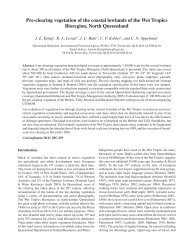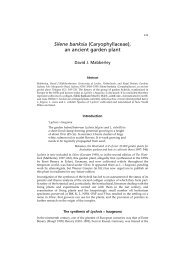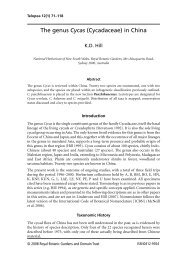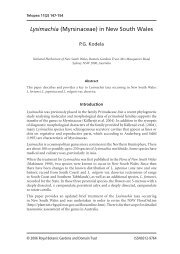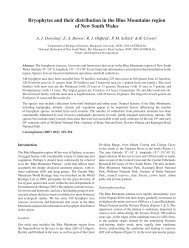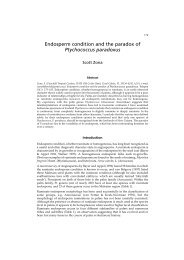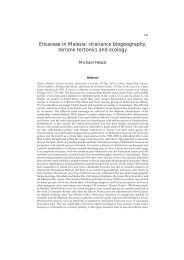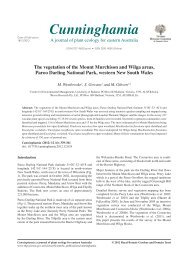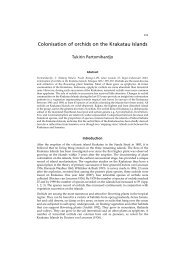The Eucalypts of the Greater Blue Mountains World Heritage Area ...
The Eucalypts of the Greater Blue Mountains World Heritage Area ...
The Eucalypts of the Greater Blue Mountains World Heritage Area ...
Create successful ePaper yourself
Turn your PDF publications into a flip-book with our unique Google optimized e-Paper software.
Cunninghamia 11(4): 2010 Hager & Benson, <strong>Eucalypts</strong> <strong>of</strong> <strong>the</strong> <strong>Greater</strong> <strong>Blue</strong> <strong>Mountains</strong> <strong>World</strong> <strong>Heritage</strong> <strong>Area</strong> 431<br />
Of those limited to one national park (Table 1b), some are at<br />
<strong>the</strong> edge <strong>of</strong> a much wider distribution beyond <strong>the</strong> GBMWHA.<br />
(e.g. Eucalyptus dwyeri, Eucalyptus muelleriana). O<strong>the</strong>rs<br />
are very restricted. Some such as Eucalyptus bensonii,<br />
Eucalyptus baeuerlenii, and Eucalyptus laophila are<br />
very restricted but have most or all <strong>of</strong> <strong>the</strong>ir distribution<br />
protected within <strong>the</strong> GBMWHA. O<strong>the</strong>rs (e.g. Eucalyptus<br />
hypostomatica, Eucalyptus michaeliana) have reasonably<br />
large populations within <strong>the</strong> GBMWHA. Six <strong>of</strong> <strong>the</strong> rare<br />
eucalypts are mallees with three being endemic to <strong>the</strong><br />
GBMWHA (Eucalyptus bensonii, Eucalyptus burgessiana,<br />
Eucalyptus cunninghamii).<br />
O<strong>the</strong>r restricted species are less well protected. Six are<br />
listed as vulnerable under <strong>the</strong> NSW Threatened Species<br />
Conservation Act (TSC Act) a low proportion (6%) compared<br />
with listings for o<strong>the</strong>r parts <strong>of</strong> NSW as <strong>the</strong> extensive area <strong>of</strong><br />
<strong>the</strong> GBMWHA has provided conservation security for most<br />
species. Two <strong>of</strong> <strong>the</strong>se species are also listed as Vulnerable<br />
under <strong>the</strong> Commonwealth Environment Protection and<br />
Biodiversity Conservation (EPBC) Act. Due to <strong>the</strong>ir small<br />
population sizes, <strong>the</strong> primary threat to Eucalyptus fracta<br />
and Eucalyptus corticosa are risks from chance stochastic<br />
events. Eucalyptus aggregata, Eucalyptus cannonii and<br />
Eucalyptus macarthurii primarily occur on agricultural<br />
lands with modified pastures. <strong>The</strong>y are threatened by lack<br />
<strong>of</strong> regeneration and are poorly represented in conservation<br />
reserves. Eucalyptus benthamii is threatened by increased<br />
nutrients, frequent burning and weed invasion in its habitat<br />
<strong>of</strong> alluvial flats. Much <strong>of</strong> its habitat has been cleared for<br />
agriculture or submerged beneath <strong>the</strong> waters <strong>of</strong> Lake<br />
Burragorang (Benson 1985).<br />
Eucalyptus dawsonii is a community dominant in <strong>the</strong><br />
Vulnerable Ecological Community Hunter Valley Footslopes<br />
Slaty Gum Woodland in <strong>the</strong> Sydney Basin Bioregion that<br />
occurs below <strong>the</strong> escarpment in nor<strong>the</strong>rn Wollemi NP near<br />
Jerrys Plains. This community is threatened by clearing,<br />
emerging weeds and frequent burning (Peake 2006).<br />
A fur<strong>the</strong>r ten eucalypts have been recognised as rare on <strong>the</strong><br />
list <strong>of</strong> Rare or Threatened Australian Plants (ROTAP, Briggs<br />
& Leigh 1996).). <strong>The</strong>se eucalypts typically have a highly<br />
restricted or disjunct distribution, but are subject to a lower<br />
level <strong>of</strong> threat. A good example is Eucalyptus baeuerlenii,<br />
which has a very restricted distribution on cliff ledges at<br />
Wentworth Falls–Leura, but is within <strong>the</strong> GBMWHA and is<br />
being managed for conservation.<br />
Fig. 2. Many eucalypt species grow in <strong>the</strong> dissected sandstone landscapes <strong>of</strong> <strong>the</strong> <strong>Blue</strong> <strong>Mountains</strong> and Wollemi areas where habitats range<br />
from moist sheltered gullies to exposed ridges and clifflines.




